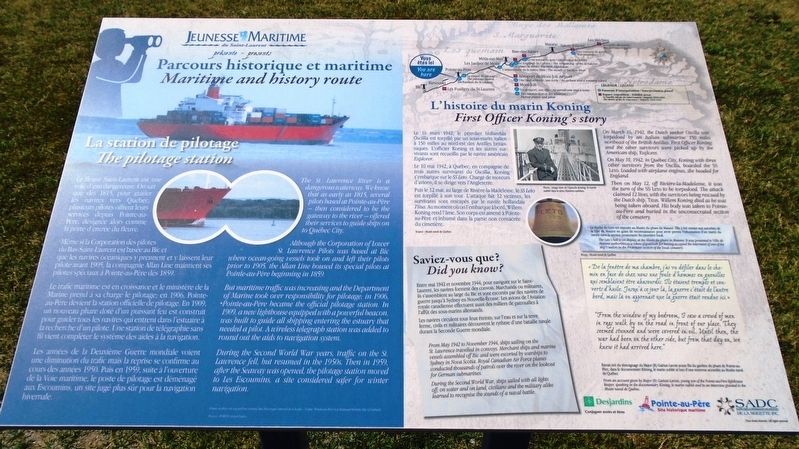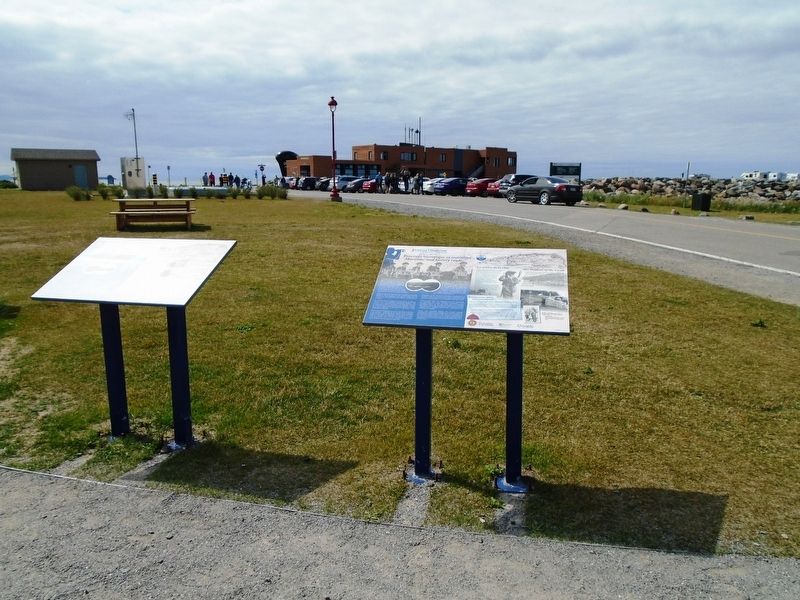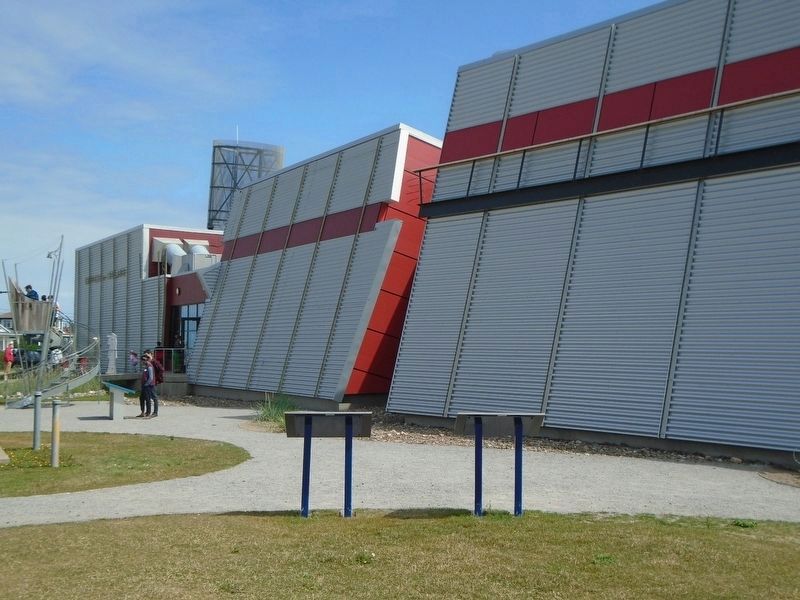La station de pilotage / The pilotage station
L'histoire du marin Koning / First Officer Koning's story
— Parcours historique et maritime / Maritime and history route —
La station de pilotage
Le fleuve Saint-Laurent est une voie d'eau dangereuse. On sait que dès 1815, pour guider les navires vers Québec, plusieurs pilotes offrent leurs services depuis Pointe-au-Père, désignée alors comme la porte d'entrée du fleuve.
Même si la Corporation des pilotes du Bas-Saint-Laurent est basée au Bic et que les navires océaniques y prennent et y laissent leur pilote avant 1905, la compagnie Allan Line maintient ses pilotes spéciaux à Pointe-au-Père dès 1859.
Le trafic maritime est en croissance et le ministère de la Marine prend à sa charge le pilotage; en 1906, Pointe-au-Père deveient la station officielle de pilotage. En 1909, un nouveau phare doté d'un puissant feu est construit pour guider tous les navires qui entrent dans l'estuaire à la recherche d'un pilotage. Une station de télégraphie sans fil vient compléter le système des aides à la navigation.
Les années de la Deuxième Guerre mondiale voient une diminution du trafic mais la reprise se confirme au cours des années 1950. Puis en 1959, suite à l'ouverture de la Voie maritime, le poste de pilotage est déménagé aux Escoumins, un
site jugé plus sûr pour la navigation hivernale.Pointe-au-Père est aujourd'hui nommè lieu historique national du Canada
L'histoire du marin Koning
Le 16 mars 1942, le pétolier hollandais Oscilla est torpillé par un sou-marin italien à 150 milles au nord-est des Antilles britanniques. L'officier Koning et les autres survivants sont recueilles par le navire américain Explorer.
Le 10 mai 1942, à Québec, en compagnie de trois autres survivants du Oscilla, Koning s'embarque sur le SS Leto. Chargé de moteurs d'avions, il se dirige vers l'Angleterre.
Puis le 12 mai, au large de Rivière-la-Madeleine, le SS Leto est torpillé à son tour. L'attaque fait 12 victimes, les survivants sont rescapés par le navire hollandais Titus. Au moment où on l'embarque à bord, Willem Koning rend l'âme. Son corps est amené à Pointe-au-Père et inhumé dans la partie non consacrée du cimetière.
Photo : Image tirée de l'épisode Koning, le marin oublié dans la série Histoires oubliées.
La cloche du Leto est exposée au Musée du phare de Matane. Elle a été remise aux autorités de la Ville de Matane en quise de reconnaissance pour avoir permis l'inhumation d'un marin du navire dans la section protestante du cimetière local.
« De la fenêtre de ma chambre, j'ai vu défiler dans le chemin en face
Extrait tiré du témoignage du Major (R) Gaétan Lavoie jeune fils du gardien de phare de Pointe-au-Père, dans le documentaire Köning, le marin oublié et lors d'une entrevue accordée au Musée naval de Québec
Saviez-vous que?
Entre mai 1942 et novembre 1944, pour naviguer sur le Saint-Laurent, les navires forment des convois. Marchands ou militaires, ils s'assemblent au large du Bic et sont escortés par des navires de guerre jusqu'à Sydney en Nouvelle-Écosse. Les avions de l'Aviation royale canadienne effectuent aussi des milliers de patrouilles à l'affût des sous-marins allemands.
Les navires circulent tous feux éteints; sur l'eau et sur la terre ferme, civils et militaires découvrent le rythme d'une bataille navale durant la Seconde Guerre mondiale.
The St. Lawrence River is a dangerous waterway. We know that as early as 1815, several pilots based at Pointe-au-Père — then considered to be the gateway to the river
Although the Corporation of Lower St. Lawrence Pilots was based at Bic where ocean-going vessels took on and left their pilots prior to 1905, the Allan Line housed its special pilots at Pointe-au-Père beginning in 1859.
But maritime traffic was increasing and the Department of Marine took over responsibility for pilotage; in 1906, Pointe-au-Père became the official pilotage station. In 1909, a new lighthouse equipped with a powerful beacon, was built to guide all shipping entering the estuary that needed a pilot. A wireless telegraph station was added to round out the aids to navigation system.
During the Second World War years, traffic on the St. Lawrence fell, but resumed in the 1950s. Then in 1959, after the Seaway was opened, the pilotage station moved to Les Escoumins, a site considered safer for winter navigation.
Today, Pointe-au-Père is a National Historic Site of Canada.
First Officer Koning's story
On March 16, 1942, the Dutch tanker Oscilla was torpedoed by an Italian submarine 150 miles northeast of the British Antilles. First Officer Koning and the other survivors were picked up by the American ship, Explorer.
On May 10, 1942, in Québec City, Koning and three other survivors from the Oscilla, boarded the SS Leto. Loaded
with airplane engines, she headed for England.
Then on May 12, off Rivière-la-Madeleine, it was the turn of the SS Leto to be torpedoed. The attack claimed 12 lives, with the survivors being rescued by the Dutch ship, Titus. Willem Koning died as he was being taken aboard. His body was taken to Pointe-au-Père and buried in the unconsecrated section of the cemetery.
Photo: Image taken from episode Koning, the forgotten sailor in the series Forgotten Stories.
The Leto's bell is on display at the Musée du phare in Matane. It was presented to Ville d Matane authorities as a token of gratitude for having accepted the interment of one of the ship's sailors in the Protestant section of the local cemetery.
"From the window of my bedroom, I saw a crowd of men in rags walk by on the road in front of our place. They seemed stunned and were covered in oil. Until then, the war had been on the other side, but from that day on, we knew it had arrived here."
From an account given by Major (R) Gaétan Lavoie, young son of the Pointe-au-Père lighthouse keeper, speaking in the documentary Köning, la marin oublié and in an interview granted to the Musée naval de Québec.
Did you know?
From May 1942 to November 1944, ships sailing on the St. Lawrence travelled in convoys. Merchant ships and marine vessels assembled off Bic and were escorted by warships to Sydney in Nova Scotia. Royal Canadian Air Force planes conducted thousands of patrols over the river on the lookout for German submarines.
During the Second World War, ships sailed with all lights off; on water and on land, civilians and the military alike learned to recognise the sounds of a naval battle.
Erected by Pointe-au-Père site historique maritime, Desjardins, and SADC.
Topics. This historical marker is listed in these topic lists: Disasters • War, World II • Waterways & Vessels. A significant historical year for this entry is 1815.
Location. 48° 31.031′ N, 68° 28.151′ W. Marker is in Rimouski, Québec, in Rimouski-Neigette. Marker is on rue du Phare, on the right when traveling east. Marker is adjacent to the Empress of Ireland Museum, at Pointe-au-Père Maritime Historical Site. Touch for map. Marker is at or near this postal address: 1000 rue du Phare, Rimouski QC G5M 1L8, Canada. Touch for directions.
Other nearby markers. At least 8 other markers are within walking distance of this marker. Les Fusiliers du St-Laurent (here, next to this marker); Père Nouvel (a few steps from this marker); Les gardiens de phare / The lightkeepers (a few steps from this marker); Les pilotes / The pilots (within shouting distance of this marker); Polyvalence / Versatility (within shouting distance of this marker); Fumée de mer / Smoke from the Sea (within shouting distance of this marker); Les pilotes du Saint-Laurent / St. Lawrence Pilots (within shouting distance of this marker); Le phare de Pointe-au-Père / Point-au-Père Lighthouse (within shouting distance of this marker). Touch for a list and map of all markers in Rimouski.
Also see . . .
1. Pilotage in Canada: Laurentian Region. (Submitted on December 9, 2018, by William Fischer, Jr. of Scranton, Pennsylvania.)
2. The Pilots of Point-au-Père. (Submitted on December 9, 2018, by William Fischer, Jr. of Scranton, Pennsylvania.)
Credits. This page was last revised on January 20, 2020. It was originally submitted on December 8, 2018, by William Fischer, Jr. of Scranton, Pennsylvania. This page has been viewed 166 times since then and 16 times this year. Photos: 1, 2. submitted on December 9, 2018, by William Fischer, Jr. of Scranton, Pennsylvania. 3. submitted on December 10, 2018, by William Fischer, Jr. of Scranton, Pennsylvania.


